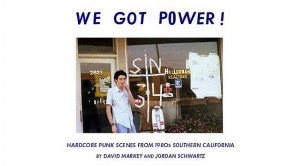WE GOT POWER: Photo-essay book depicts So Cal hardcore punk scenes

Over the years, plenty of writers have tried to document the punk rock scene in print. David Markey and Jordan Schwartz’s WE GOT POWER: Hardcore Punk Scenes From 1980s Southern California is one of the best books on the subject. Filled with fascinating essays and terrific photos, it’s a terrific read. We did a quick phone interview with Markey, who has also released a documentary on the Circle Jerks this year. “I’ve been in involved in a lot of these bands in a lot of different ways over the years,” says Markey. Here’s what he had to say on the subject.
Talk a bit about your background.
I grew up in Los Angeles. I was born here. I’m a native. I’m one of the rare California natives. I was always an enterprising kid. I was the kid who made 8mm films, all pre-punk, all pre-involvement in music. I was a busy enterprising kid. In my teen years, I got into music. I had always liked music even before that. I was always buying 45s and taping things off the radio. Things changed and stepped up when I got into my teen years. I discovered bands like Devo and Talking Heads, which warmed me up to what as going in Los Angeles late ’70s and early ’80s. At that time, the punk scene was shifting into this more suburban thing. I got caught up in that. I started a band and with a few friends started the We Got Power fanzine in 1981. At that point in time, things really changed and my focus moved out of the neighborhood at it was to a much larger thing.
When you see that punk became more suburban, are you referring to Orange County?
Los Angeles is teeming with cities all around it. Santa Monica where I grew up wasn’t exactly the suburbs. For all intents and purposes, it’s half suburb and half city. It didn’t have a music scene at the time. There were just a few people who were grooving to this music.
How long did you keep the band going?
The band lasted until 1984, which is about a year after the magazine ran out of steam. During the time, Jordan Schwartz and I were able to capture thousands of images that we thankfully saved and archived. Many years later, we uncovered them and began the process of digitizing. At that point, we realized that we had something special.
The photos are great.
It was all self-taught. I also encouraged Jordan. Jordan lived up the street from me and I met him in 1979. I got him to come to my school. He was going to a private school at the time. We took photography classes together. We were getting involved on a very underground level with the hardcore thing that was happening.
It was different going to the X show, for sure. That was our first encounter with the rougher elements of Southern California hardcore. Namely, we ran headfirst into the HBs — the Huntington Beach skinheads — who took offense at our long hair. They proceeded to give us shit and the rest is history.
Do you remember the first punk rock show you ever saw?
The first one proper would have been X, The Blasters and The Gears at the Santa Monica Civic. That was the one venue in our town that had shows. The Clash played there and the Buzzcocks and Devo. It was different going to the X show, for sure. That was our first encounter with the rougher elements of Southern California hardcore. Namely, we ran headfirst into the HBs — the Huntington Beach skinheads — who took offense at our long hair. They proceeded to give us shit and the rest is history.
It’s weird to think that skinheads would be at an X show.
At the time, things were very different here. X was one of the first original L.A. punk bands to break through. They were on a semi-independent label with mainstream distribution. That record really got out there and the Dead Kennedys record had come out and the Germs was out and The Decline of Western Civilization soundtrack came out in 1980. And that gave us a good entry point to these bands like Circle Jerks, Fear, X, and we got into even deeper than that and started seeking out the hundreds of bands happening in L.A. at the time. We dove into it headfirst. It gave us something amazing to document. We were serious about it even though we were kids having a good time. We realized the importance of it all.
Do you think the punk scene is vibrant now?
I don’t know. What scene are you talking about? First of all, it went national but was still on an underground level in the ‘80s. It fizzled out toward the late ‘80s. Then, the early ‘90s came around and all of a sudden Nirvana happened and they shed a lot of light back into the past and pushed these former underground bands into a certain level by mentioning them in interviews and saying they were inspired by Black Flag and Butthole Surfers. Then, the early ‘90s happened and all these other bands started coming up and the Green Days and the Offsprings started coming up. Back then, we called it a scene because there was a scene. Now, I don’t think it is that per se. This music got to a lot of people and everyone has their own idea of what punk rock is. These days, it’s pretty easy for a band to call themselves that these days, but it’s a different world now. The ideas and the music is there and it’s never gone away.

















